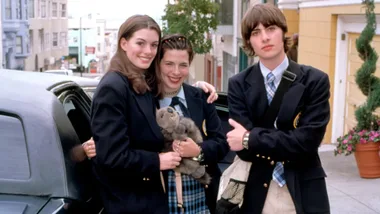Most people will attest there is something of a ‘marriage era’. Starting around your mid-to-late 20s and lasting at least a few years, it’s a period during which more weekends than not are dedicated to celebrating peoples’ ‘family milestones’. Engagement parties, hens nights, weddings, baby showers, (heaven forbid) gender reveal parties… life becomes defined by this endless parade of benchmark celebrations.
Now, at the age of 32, I’m starting to notice a new milestone trend. I’m calling it the “divorce era”.
I first noticed it on my dating apps. More once-married men were popping up, a fact I’d learn on the first date (if it wasn’t already obvious by their profile). Even men who weren’t technically ever married, and thus not technically divorced, were exiting long term relationships, with kids, houses or pets to share.
Then, in the first few months of this year, not one, but two of my close friends separated from their long term partners. While two does not make a ‘trend’, I don’t have that many close friends — so, percentage-wise, it’s huge!
And thus I wondered: Is this a thing? Just as I watched my friends partner-up within the space of a handful of years, am I now going to watch them separate within a similarly brief time frame?
Statistically, it could be true.

When you look at Australian divorce statistics, an overwhelming number of separations occur within the first nine years of marriage. In fact, of all divorces recorded, a whopping 56% of couples called it quits within that first nine years, with an average timeframe of marriage to separation only 8.7 years. A further 26% of couples split within 10 to 19 years, while just 15% of couples call it quits after 20 years. In other words: more than half of all marriages that end in divorce, end within that first decade.
On top of that, AIFS researcher Dr Lixia Qu confirms that the age bracket with the greatest percentage of divorces is 35-39. So, while my friends separating in their early thirties might be a little off-the-mark, perhaps we are indeed collectively heading into our ‘divorce era’ in a matter of years. (And, actually, it takes an average of around three years for a divorce to be settled — so, perhaps my pals are right on time.)
While we don’t have the same data for cohabitating partnerships, the Australian Institute of Family Studies [AIFS] concludes it is even more likely for couples to separate if they never got married.
So, the next obvious question is: why? Why this specific time frame? Why this age? Is it finance? Is it kids? Or is it the inevitable demise of romance?

Investigating The ‘Seven Year Itch’
When pondering these statistics (particularly the 8.7-year separation average), one can’t help but immediately recall the ‘seven year itch’.
Ever since Marilyn Monroe donned a flowy, white dress and stood over a subway grate, folks have debated whether the idea of a ‘seven year itch’ was based in fiction or fact. The phrase refers to the approximate time-period in a relationship where the ‘honeymoon phase’ has well-and-truly worn off, and reality comes knocking. It’s when you and your partner settle into the humdrum of life together, leading many to wonder if the relationship will continue to satisfy their desires.
Looking at the statistics, this theory of a ‘seven year itch’ — or, technically, 8.7 year itch — may have some legs.
“The research shows that [the seven year itch] is generally when couples become immersed in raising children, paying off the mortgage and being responsible. They lose sight of themselves as a couple and as individuals, and this is when people jump out of relationships and into new ones,” divorce lawyer Cassandra Kalpaxis tells marie claire Australia.
“It’s the thrill and the attention of being valued and appreciated again for who they are and not their label.”

Relationships Australia CEO and clinical psychologist Elisabeth Shaw agreed that the early years of relationships are typically focused around shared goals — a needle which can shift after some, or all, of these goals are achieved.
“In the first years of a relationship, there are many exciting and bonding challenges to face, [such as moving into your] first home, career progression, saving for a property — all of which are highly romantic, take time, and [are focused] on common goals and aspirations,” she says. “If there is not a time imperative to have children, this can also be a period of enjoying double income, travel and connection with friends.”
Once this ongoing period of novelty peters out, many start to take stock of their relationship, especially when the conversation turns to having children (or not).
“There could be differences about wanting children, or career opportunities that have taken off that challenge their picture of their future. For example, one person receives an offer to work overseas,” Elisabeth offers.
“Nine years is enough time to know each other well, but also to have had the early romance settle into what the future might look like. If couples have got together early and face relationship uncertainty, they might also see that re-partnering is possible, if they call it early enough.”
Why Are People Getting Divorced?
While Australia upholds “no fault” divorces — i.e. our courts do not consider the reason/s a marriage has ended when granting divorce — separate research suggests domestic violence or abuse is the main reason people get divorced.
Another common reason? Communication issues.
“This covers a wide range of issues such as difficulty seeing each other’s point of view, conflict management, poor styles of discussion, not being able to get through to each other and be heard,” Elisabeth explains.
Beyond this, infidelity, substance abuse, financial issues and parenting conflicts are also key reported reasons.
What’s Age Got To Do With It?
AIFS researcher Dr Lixia Qu confirms there is evidence that marrying at a younger age is associated with a higher likelihood of divorce.
And while the median age of divorce for people in Australia is 45.9 for men and 43 for women, given that the 35-39 age bracket contains the most divorces, it could be the seven year itch striking those who’ve married young, or around the median ages of 30.8 (men) and 29.4 (women).
Elisabeth also suggests that younger people might be more inclined to split given their assumed years ahead.
“Without the social imperative to stay together against all odds (which used to be expected), people who are unhappy and still young are more likely to call it with the chance to move on, than a couple in their 70s for example, because there is often a desire to find happiness elsewhere,” she says.

While the ‘divorce era’ might sound daunting to some, there is some good news: most Australian marriages don’t end in divorce at all. (Sure, the divorce rate might be 48%, but are you a glass half full or empty person?)
Same-sex couples have heterosexual couples beat when it comes to divorce rates, with just 2.5% of same-sex couples splitting up. However, given same-sex marriage was only legalised in 2017, and divorce rates have only been recorded since 2021, it might be a little early to start reading too deeply into these figures.
And while there’s no denying divorces and break-ups are taxing on the individuals and families involved, it bears repeating that leaving an unhappy partnership is never a bad thing. To the contrary, in fact. If Diane Lane, Julia Roberts and the ladies of the First Wives Club have taught me anything, it’s that divorce certainly agrees with some, especially when we can eat, pray, love our way back to happiness — and into a multi-million dollar memoir.









